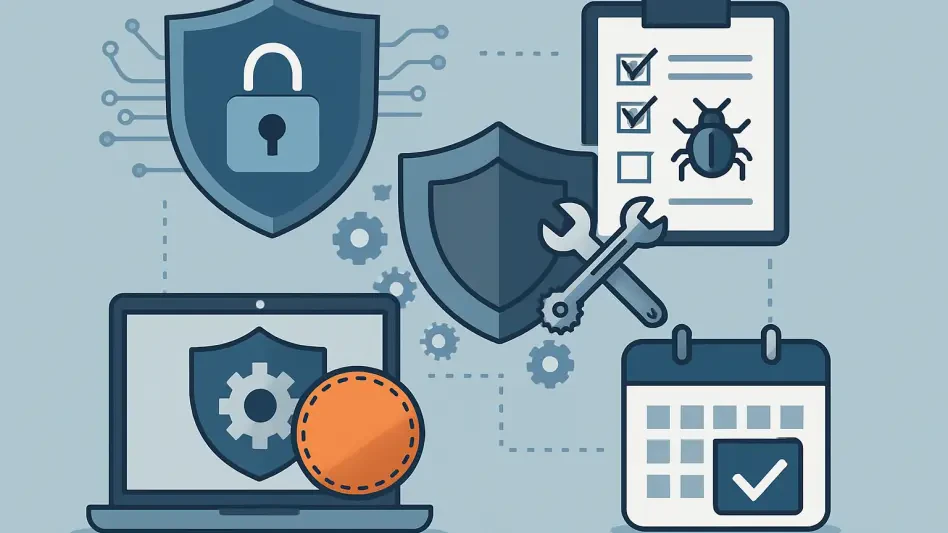In an era where cyber threats evolve at an alarming pace, the importance of robust cybersecurity measures cannot be overstated, especially when it comes to patch management as a critical line of defense. Organizations across the globe are grappling with sophisticated attacks like ransomware and zero-day exploits, which often target unpatched vulnerabilities in software systems. This reality places patch management at the forefront of IT security strategies, ensuring that systems are updated and protected against known risks. The process, which involves identifying, deploying, and verifying software updates, acts as a safeguard, much like securing the doors and windows of a house against intruders. With the digital landscape becoming increasingly complex due to remote work and diverse devices, businesses—from small startups to large enterprises—must prioritize tools that streamline this essential task. This article explores ten leading patch management solutions designed to meet the security challenges of today, offering insights into their unique capabilities and how they address varying organizational needs. These tools have been selected based on their effectiveness, user feedback, and alignment with trusted cybersecurity standards from bodies like NIST and CISA. Beyond just software, a strategic approach to patch management is vital, integrating best practices to build a resilient security posture. As cyber risks continue to mount, understanding the strengths of these solutions becomes a roadmap for IT teams aiming to protect their infrastructure from ever-evolving threats.
The Critical Role of Patch Management
Addressing Vulnerabilities in Real Time
Patch management serves as a fundamental pillar of cybersecurity by directly tackling vulnerabilities that attackers exploit to gain unauthorized access or disrupt systems. In an environment where hackers can weaponize software flaws within hours of their discovery, timely updates are not just beneficial—they are imperative. These tools ensure that patches are applied swiftly across all endpoints, whether dealing with a handful of devices or thousands in a sprawling network. The risk of data breaches, ransomware attacks, and other cyber incidents drops significantly when systems are kept current, as many exploits rely on outdated software to succeed. Moreover, the automation features embedded in modern solutions reduce the likelihood of human error, which often delays critical updates. By prioritizing speed and consistency, patch management tools help organizations stay one step ahead of malicious actors looking to capitalize on unpatched weaknesses.
Ensuring Regulatory Compliance
Beyond immediate security benefits, patch management plays a crucial role in meeting regulatory and industry standards, a pressing concern for businesses in sectors like finance, healthcare, and government. Non-compliance can lead to hefty fines, legal repercussions, and damage to reputation, making adherence a top priority for IT teams. Many of the leading tools provide detailed reporting and vulnerability scanning capabilities, enabling organizations to demonstrate compliance with frameworks such as those outlined by NIST or specific mandates like GDPR and HIPAA. These features allow businesses to track patch deployment, identify gaps, and address them before audits or inspections. Additionally, alignment with resources like CISA’s Known Exploited Vulnerabilities Catalog ensures that the most critical threats are prioritized, reinforcing a proactive stance on risk mitigation. This dual focus on security and compliance underscores why patch management is indispensable in today’s tightly regulated digital ecosystem.
Essential Features of Leading Patch Management Solutions
Automation as a Core Strength
One of the standout characteristics of today’s patch management tools is their emphasis on automation, a feature that significantly enhances efficiency across diverse IT environments. Managing updates manually is not only time-consuming but also prone to errors, especially in organizations with numerous endpoints or remote workforces. Solutions like Automox and NinjaOne excel in automating the entire patching lifecycle—from identifying needed updates to deploying and verifying them—ensuring no device is overlooked. This capability is particularly valuable for IT teams stretched thin by other responsibilities, as it minimizes operational overhead and guarantees timely responses to emerging vulnerabilities. The result is a more secure infrastructure without the constant need for manual intervention, allowing staff to focus on strategic priorities rather than routine maintenance tasks.
Seamless Integration with Broader IT Systems
Another defining trait of top-tier patch management tools is their ability to integrate with other IT management functions, creating a cohesive ecosystem for administrators. Platforms like Kaseya and Atera go beyond standalone patching, combining capabilities such as remote monitoring, IT service management, and even professional services automation into a single interface. This all-in-one approach reduces the clutter of multiple tools, streamlining workflows and improving visibility across operations. For businesses, this means less time spent switching between disparate systems and more focus on addressing critical issues as they arise. Integration also fosters better data sharing between security and operational teams, ensuring that patch management aligns with overarching IT strategies. Such synergy is essential for organizations aiming to optimize resources while maintaining robust defenses against cyber threats.
In-Depth Look at Leading Patch Management Tools
Microsoft Intune for Ecosystem Synergy
Microsoft Intune emerges as a powerful choice for organizations deeply embedded in the Microsoft ecosystem, delivering unified endpoint management across a range of platforms including Windows, macOS, iOS, and Android. Its tight integration with Microsoft 365 and Azure Active Directory allows for seamless policy enforcement, conditional access, and compliance tracking, making it a go-to for businesses leveraging these services. IT teams benefit from centralized control over device security, ensuring patches are applied consistently while supporting bring-your-own-device policies. However, its complexity in mixed or non-Microsoft environments can pose challenges during setup and management, requiring specialized expertise. Despite this, for companies already invested in Microsoft’s suite, Intune offers unparalleled synergy that enhances overall security posture.
Intune’s strength lies in its ability to manage diverse endpoints under a single pane of glass, which is critical in today’s hybrid work settings where employees use varied devices. The tool’s compliance policies help enforce standards across the board, alerting administrators to non-compliant systems that need immediate patching. Additionally, its cloud-based nature ensures updates can be pushed without reliance on traditional network constraints, a boon for remote teams. While licensing costs and configuration intricacies may deter smaller organizations, those with the resources to navigate these hurdles find Intune a reliable ally in maintaining a fortified IT environment against evolving threats.
NinjaOne and Atera for Smaller Operations
NinjaOne and Atera cater specifically to small and medium-sized businesses (SMBs) and managed service providers (MSPs), offering intuitive platforms that balance functionality with affordability. NinjaOne stands out with its user-friendly interface and strong automation features, enabling IT teams to manage patch deployment, backups, and IT documentation effortlessly. This reduces operational strain for smaller staffs often juggling multiple roles. Meanwhile, Atera’s unique per-technician pricing model provides cost predictability, making it an attractive option for MSPs scaling their services. Both tools deliver all-in-one solutions that minimize the need for additional software, addressing the resource constraints typical of smaller entities.
While NinjaOne focuses on simplicity and efficiency, making it ideal for small and medium-sized businesses (SMBs) seeking to streamline IT operations without heavy technical overhead, Atera adds value through integrated help desk and professional services automation features. This allows managed service providers (MSPs) to offer comprehensive support to clients while maintaining updated systems. However, both may lack the advanced capabilities required by larger enterprises, such as extensive customization or in-depth security analytics. For their target audience, though, they provide a practical entry point into effective patch management, ensuring security without overwhelming budgets or staff. Their cloud-based designs further support remote management, aligning with the needs of distributed teams prevalent in modern business structures.
Ivanti and Kaseya for Large-Scale Deployments
Ivanti and Kaseya are tailored for larger enterprises and MSPs, delivering comprehensive solutions that address complex IT environments with thousands of endpoints. Ivanti, recognized as a leader in Gartner’s Magic Quadrant for unified endpoint management, incorporates AI-driven automation to prioritize patches and manage vulnerabilities effectively. Its broad suite integrates security operations with IT management, offering a holistic approach for organizations with intricate needs. On the other hand, Kaseya provides a robust platform combining remote monitoring, IT service management, and security features, catering to MSPs overseeing multiple clients. Both tools are built for scale, handling diverse systems with precision.
Despite their strengths, Ivanti and Kaseya come with notable considerations, such as higher costs and steeper learning curves that may challenge smaller teams or those with limited budgets. Ivanti’s complexity can require significant training to fully leverage its capabilities, while Kaseya has faced scrutiny over pricing transparency and support responsiveness in some user feedback. Nevertheless, for enterprises needing deep functionality and integration, these tools provide unmatched control and visibility. Their ability to unify patch management with broader IT strategies ensures that large organizations can maintain security across sprawling infrastructures, even as threats grow more sophisticated and persistent.
Automox for Cloud-Based Efficiency
Automox distinguishes itself with a cloud-native approach to endpoint hardening, automating patch management across Windows, macOS, and Linux systems without the need for VPNs or on-site servers. This makes it particularly suited for distributed workforces, where employees operate from various locations and networks. The tool streamlines the entire patching process, from vulnerability identification to update deployment, ensuring that remote devices remain secure regardless of their physical location. Its focus on automation reduces the burden on IT staff, allowing them to address other pressing concerns while maintaining a consistent security baseline across all endpoints.
While Automox excels in flexibility and ease of use for remote environments, its pricing structure can become a hurdle for organizations with extensive device counts, as costs scale with volume. Additionally, businesses requiring on-premises control may find its cloud-only model less appealing compared to hybrid alternatives. Nevertheless, for companies prioritizing modern, agile IT management, Automox offers a forward-thinking solution that aligns with the realities of hybrid work. Its ability to manage diverse operating systems without traditional network dependencies positions it as a key player in addressing the dynamic security challenges faced by today’s decentralized organizations.
GFI LanGuard for Traditional Infrastructure
GFI LanGuard targets SMBs that prefer on-premises solutions, focusing on detailed vulnerability scanning and security auditing within localized network environments. It excels in Windows-heavy setups, providing granular control over patch deployment and compliance reporting to ensure systems meet necessary standards. This makes it a reliable choice for businesses with traditional IT infrastructures that prioritize direct oversight and are less reliant on cloud technologies. Its straightforward approach to identifying and remediating vulnerabilities helps smaller IT teams maintain security without needing extensive external resources or complex configurations.
However, GFI LanGuard’s limitations become apparent in environments with diverse operating systems or a need for cloud support, as it offers weaker compatibility for non-Windows devices and lacks remote management capabilities. Organizations embracing hybrid or remote work models may find its on-premises focus restrictive compared to cloud-native alternatives. Despite these constraints, for SMBs committed to maintaining control within their own data centers, GFI LanGuard delivers a focused, cost-effective toolset. Its emphasis on detailed auditing ensures that even smaller operations can address critical security gaps methodically, safeguarding against threats that target outdated software in confined network settings.
Emerging Trends in Patch Management
Cloud Adoption and Remote Work Support
The shift toward cloud-native patch management tools is a defining trend in 2025, driven by the persistent rise of remote and hybrid work models. Solutions like Automox and Microsoft Intune are at the forefront, offering capabilities to manage endpoints without reliance on traditional VPNs or on-site infrastructure. This flexibility is crucial for organizations with employees scattered across geographies, ensuring that patches are applied consistently to devices regardless of location. Cloud-based systems also reduce the burden of maintaining physical servers, allowing IT teams to focus on strategic initiatives rather than hardware upkeep. As businesses continue to adapt to decentralized operations, the demand for such adaptable tools is expected to grow, reshaping how security is maintained in distributed environments.
This trend also reflects broader changes in IT priorities, where scalability and accessibility take precedence over rigid, localized control. Cloud solutions provide real-time updates and centralized dashboards, enabling administrators to monitor patch status from anywhere with an internet connection. However, concerns about data privacy and reliance on third-party providers remain, prompting some organizations to seek hybrid models that balance cloud benefits with on-premises security. Despite these challenges, the momentum toward cloud adoption signals a lasting transformation in patch management, aligning with the need for agility in an era where remote connectivity is no longer optional but essential for business continuity.
AI-Driven Prioritization and Response
Artificial intelligence is increasingly shaping patch management by enhancing how vulnerabilities are identified and prioritized for remediation. Tools like Ivanti leverage AI to analyze threat intelligence and focus on patches for the most critical exploits first, reducing the window of exposure to active threats. This capability is vital in an environment where the sheer volume of vulnerabilities can overwhelm IT teams, making manual prioritization impractical. By automating decision-making with data-driven insights, AI minimizes human error and accelerates response times, ensuring that resources are allocated to the most pressing risks rather than spread thinly across less urgent issues.
The integration of AI also extends to predictive analytics, where tools anticipate potential vulnerabilities based on historical patterns and emerging threat data, offering a proactive rather than reactive approach. This forward-looking stance is particularly beneficial for organizations facing sophisticated attacks that evolve rapidly. While AI enhances efficiency, it does require robust data inputs and continuous updates to remain effective, posing a challenge for under-resourced teams. Nevertheless, as AI technology matures, its role in patch management is set to expand, providing a smarter way to navigate the complex threat landscape and fortify defenses against exploits that target unpatched systems with alarming precision.
Standardization with Cybersecurity Frameworks
Alignment with established cybersecurity frameworks from organizations like NIST and CISA is a growing trend among leading patch management tools, ensuring a structured and prioritized approach to vulnerability remediation. These guidelines, such as NIST’s Special Publication 800-40, offer a lifecycle model for patch identification, testing, and deployment, helping businesses avoid ad-hoc practices that leave gaps in security. Similarly, CISA’s Known Exploited Vulnerabilities Catalog directs focus to threats actively exploited in the wild, enabling IT teams to address the most immediate dangers. Tools integrating these standards provide built-in compliance features, simplifying adherence for regulated industries.
This trend toward standardization fosters consistency across diverse organizations, creating a shared language and methodology for tackling vulnerabilities. It also enhances trust in patch management solutions, as alignment with authoritative bodies signals reliability and thoroughness in design. However, adopting these frameworks can require additional training and process adjustments, especially for smaller firms unfamiliar with formal cybersecurity protocols. Despite this, the push for standardized practices is a positive development, equipping businesses with proven strategies to bolster their defenses while ensuring that patch management aligns with broader industry efforts to combat cybercrime systematically.
Navigating the Selection Process
Tailoring Solutions to Organizational Scale
Choosing the right patch management tool hinges on the size and structure of an organization, as needs vary dramatically between SMBs and large enterprises. Smaller businesses often benefit from cost-effective, user-friendly options like Atera or NinjaOne, which provide essential patching capabilities without overwhelming complexity or expense. These tools are designed to support limited IT staff, offering automation and intuitive interfaces that simplify security tasks. Conversely, enterprises with vast networks and diverse endpoints require robust platforms like Ivanti or Kaseya, which handle scale through advanced features and integrations, despite their higher costs and learning curves. Matching a tool to organizational size ensures that security measures are neither underpowered nor unnecessarily cumbersome.
Beyond sheer numbers, the nature of an organization’s operations also influences tool selection, as factors like remote versus in-office work impact deployment preferences. SMBs with localized setups might opt for on-premises solutions like GFI LanGuard for direct control, while enterprises with global teams lean toward cloud-based tools like Automox for accessibility. Assessing current and future growth is equally important, as scalability prevents the need for frequent tool changes. A mismatched solution can lead to inefficiencies or security gaps, so a thorough evaluation of headcount, device diversity, and operational reach is critical before committing to a platform that will underpin cybersecurity efforts.
Weighing Costs Against Capabilities
Budget considerations play a significant role in selecting a patch management tool, as financial constraints must be balanced with the need for robust functionality to protect against cyber threats. Tools like ManageEngine offer modular pricing, allowing organizations to pay only for needed features and scale as requirements grow, making them appealing for cost-conscious businesses. On the other hand, comprehensive solutions like SolarWinds provide deep visibility into complex infrastructures, ideal for IT professionals managing intricate setups, though they come with higher price tags and historical security concerns that warrant scrutiny. Striking a balance ensures that security isn’t compromised by underfunding nor burdened by overinvestment in unneeded features.
Cost isn’t just about upfront expenses but also long-term value, including support quality, ease of implementation, and potential downtime reduction through effective patching. Cheaper tools might save money initially but falter under heavy workloads or lack critical updates, while premium options could strain budgets without delivering proportional benefits if their full capabilities go unused. Additionally, hidden costs like training or integration efforts should factor into decisions, as they can inflate the total investment. A detailed cost-benefit analysis, aligned with specific security goals and operational demands, is essential to select a tool that delivers maximum protection without financial overreach, ensuring sustainable cybersecurity for the organization.
Building a Resilient Future with Patch Management
Reflecting on Strategic Implementation
Looking back, the exploration of patch management tools revealed a diverse array of solutions that tackled the pressing cybersecurity challenges organizations faced. Each platform, from Microsoft Intune’s ecosystem integration to Automox’s cloud-native automation, addressed specific vulnerabilities and operational needs with precision. The emphasis on automation, as seen in tools like NinjaOne, alleviated the manual burdens that once plagued IT teams, while comprehensive suites like Kaseya supported large-scale environments with integrated functionality. Alignment with frameworks from NIST and CISA provided a structured backbone, ensuring that patching efforts were not just reactive but strategically sound. This range of capabilities underscored how far the industry has advanced in equipping businesses against relentless cyber threats.
Moving Forward with Actionable Steps
As organizations plan their next moves, the focus should shift to actionable implementation, starting with a thorough assessment of current IT environments to identify gaps in patch management. Prioritizing tools that match specific needs—whether scalability for enterprises or affordability for SMBs—ensures a tailored fit that maximizes security outcomes. Beyond selection, integrating these solutions with existing workflows and training staff on their use will be critical to seamless adoption. Regular reviews of patch deployment success rates and compliance status, guided by authoritative resources, can help refine strategies over time. Additionally, staying informed about emerging trends like AI prioritization will prepare businesses for future threats, fostering a proactive stance that keeps defenses robust in an ever-shifting digital landscape.








